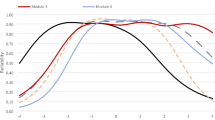Abstract
Despite the well-known difficulties in obtaining reliable and valid assessments of child psychopathology, investigators generally have not examined the influence of factors such as subject characteristics or the specific assessment procedures themselves on the validity of the information obtained. To address these issues, this special section presents four studies of the Diagnostic Interview Schedule for Children, in which investigators examined the impact of a range of variables on the reliability of its symptom and diagnostic information. Factors studied include interview structural characteristics; question length, complexity, and placement within the interview; and interview subject characteristics. Overall findings suggest that interview and subject characteristics exert important influences on the data obtained, and that novel approaches, such as allowing subjects a greater role in the ordering of questions to be answered, may improve the precision and accuracy of such measures of children's psychopathology.
Similar content being viewed by others
REFERENCES
Boyle, M. H., Offord, D. R., Racine, Y., Szatmari, P., Fleming, J. E., & Sanford, M. (1996). Identifying thresholds for classifying childhood psychiatric disorder: Issues and prospects. Journal of the American Academy of Child and Adolescent Psychiatry, 35, 1440-1448.
Edelbrock, C., & Costello, A. (1988). Convergence between statistically derived behavior problem syndromes and child psychiatric diagnoses. Journal of Abnormal Child Psychology, 16, 219-231.
Edelbrock, C., Costello, A. J., Dulcan, M. K., Conover, N. C., & Kalas, R. (1986). Parent-child agreement on child psychiatric symptoms assessed via structured interview. Journal of Child Psychology and Psychiatry, 27, 181-190.
Edelbrock, C., Crnic, K., & Bohnert, A. (1999). Interviewing as communication: An alternative way of administering the Diagnostic Interview Schedule for Children. Journal of Abnormal Child Psychology, 27, 447-453.
Fallon, T., Jr., & Schwab-Stone, M. (1994). Determinants of reliability in psychiatric surveys of children aged 6–12. Journal of Child Psychology and Psychiatry, 35, 1391-1408.
Gould, M. S., Bird, H., & Jaramillo, B. S. (1993). Correspondence between statistically derived behavior problem syndromes and child psychiatric diagnoses in a community sample. Journal of Abnormal Child Psychology, 21, 287-313.
Jensen, P. S., Davis, H., Xenakis, S. N., & Degroot, J. (1988). Child psychopathology rating scales and interrater agreement: II. Child and family characteristics. Journal of the American Academy of Child and Adolescent Psychiatry, 27, 451-461.
Jensen, P., Roper, M., Fisher, P., Piacentini, J., Canino, G., Richters, J., Rubio-Stipec, M., Dulcan, M., Goodman, S., Davies, M., Rae, D., Shaffer, D., Bird, H., Lahey, B., & Schwab-Stone, M. (1995). Test-retest reliability of the Diagnostic Interview Schedule for Children (ver. 2.1): Parent, child, and combined algorithms. Archives of General Psychiatry, 52, 61-71.
Jensen, P. S., Watanabe, H., & Richters, J. (1999). Who's up first? Testing for order effects in structured interviews using a counterbalanced experimental design. Journal of Abnormal Child Psychology, 27, 439-445.
Lahey, B., Flagg, E., Bird, H., Schwab-Stone, M., Canino, G., Dulcan, M., Leaf, P., Davies, M., Brogan, D., Bourdon, K., Horwitz, S., Rubio-Stipec, M., Freeman, D., Lichtman, J., Shaffer, D., Goodman, S., Narrow, W., Weissman, M., Kandel, D., Jensen, P., Richters, J., & Regier, D. (1996). The NIMH methods for the Epidemiology of Child and Adolescent Mental Disorders (MECA) Study: Background and methodology. Journal of the American Academy of Child and Adolescent Psychiatry, 35, 855-864.
Lucas, C. P., Fisher, P., Piacentini, J., Zhang, H., Jensen, P. S., Shaffer, D., Dulcan, M., Schwab-Stone, M., Regier, D., & Canino, G. (1999). Features of interview questions associated with attenuation of symptom reports. Journal of Abnormal Child Psychology, 27, 429-437.
Measelle, J. R., Ablow, J. C., Cowan, P. A., & Cowan, C. P. (1998). Assessing young children's views of their academic social, and emotional lives: An evaluation of the Self-Perception Scales of the Berkeley Puppet Interview. Child Development 69, 1556-1576.
Offord, D. R., Boyle, M. H., Racine, Y., Szatmari, P., Fleming, J. E., Sanford, M., & Lipman, E. L. (1996). Integrating assessment data from multiple informants. Journal of the American Academy of Child and Adolescent Psychiatry, 35, 1078-1085.
Piacentini, J. C., Cohen, P., & Cohen, J. (1992). Combining discrepant diagnostic information from multiple sources: Are complex algorithms better than simple ones? Journal of Abnormal Child Psychology, 20, 51-63.
Piacentini, J., Roper, M., Jensen, P., Lucas, C., Shaffer, D., Dulcan, M., Schwab-Stone, M., Regier, D., & Canino, G. (1999). Attenuation and the Diagnostic Interview Schedule for Children: Individual factors predicting attenuation. Journal of Abnormal Child Psychology, 27.
Author information
Authors and Affiliations
Rights and permissions
About this article
Cite this article
Jensen, P.S., Edelbrock, C. Subject and Interview Characteristics Affecting Reliability of the Diagnostic Interview Schedule for Children. J Abnorm Child Psychol 27, 413–415 (1999). https://doi.org/10.1023/A:1021971724048
Issue Date:
DOI: https://doi.org/10.1023/A:1021971724048




